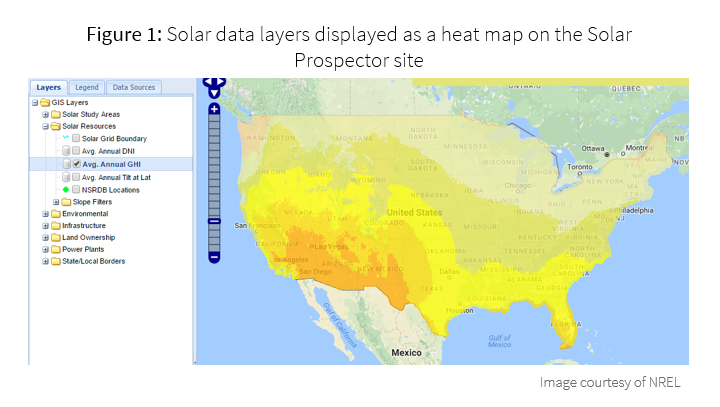Solar Prospector Sunsetting
As many of you have heard, the National Renewable Energy Laboratory (NREL) will be sunsetting the Solar Prospector tool. The Solar Prospector tool was last updated in 2012 by NREL, and its purpose was to provide mapping and data analysis in support of solar project development across the Continental U.S. and Hawaii.
Many of you also have first-hand experience with how different features of the Solar Prospector made evaluating solar projects easier. With a diverse collection of input datasets and a sleek mapping or geographic information system (GIS) layer, the Solar Prospector provided users with a source for project evaluation intelligence.
Four years since the last update, however, NREL will be removing data from the site on Friday, September 30, 2016. On and after October 1, 2016, the Solar Prospector site will no longer offer data access or mapping capability; rather it will redirect web traffic to other sources.

While data visualization was an attractive and intuitive capability, most would agree that it was not the most valuable feature of the Solar Prospector. Users could also download datasets and conduct further analysis related to solar project development. Having access to download irradiance data is an integral component to solar project development, review and financing—and continuity in data access allows users to update project forecasts at different stages of the development timeline.
Going forward: Access to Solar Prospector Data
Our SolarAnywhere® team worked closely with NREL to generate and validate the Solar Prospector irradiance dataset. Upon its launch, the Solar Prospector was populated with irradiance estimates based on the SolarAnywhere historical data model version 2.2. The solar resource group at NREL made some minor modifications to the base v2.2 model prior to release; however, the base output was largely unchanged. Presently, SolarAnywhere Data supports version 2.4 for its public users. We understand that the irradiance data from Solar Prospector is important to you. Therefore, Clean Power Research is updating free of charge public user access on the SolarAnywhere Data website to include a comparable irradiance dataset. Here’s a summary of how public access to irradiance data will change:

To request data, login as a “Public” user to SolarAnywhere and select your project site through the SolarAnywhere web map. Then, pick either an individual year or (after October 1st) Typical GHI/DNI Year when selecting a time period. Data will be available in individual calendar years from 1998 to 2013, as well as in the Typical GHI Year (TGY) and Typical DNI Year (TDY) formats based on the Solar Prospector date range of 1998 to 2009. Public data requests are delivered to the customer by email and returned based on order of request.
Optionally, as a licensed user of SolarAnywhere, you are able to directly download custom date range, full calendar year or typical year files, and request more up-to-date solar model data depending on licensed access. Please contact us if you’d like to learn more about a Time-Series or National Access Typical Year license.
Solar Resource: Research versus Bankability
Since its last update, the Solar Prospector provided access to a solar dataset that has been used through numerous project evaluations over the course of four years. During those years, however, a number of advancements have been made in solar resource research and project bankability. New solar resource models have been developed to tackle a wider range of climatic conditions with a more accurate approach.
SolarAnywhere, for instance, has launched the version 3 (“v3”) model that incorporates additional satellite infrared (IR) channels. V3 uses these additional IR image inputs from the same source satellite as used in the version 2 model, resulting in a more accurate resource estimate in all locations of comparison with notable improvement in regions with seasonal snow cover and higher ground reflectance (such as desert sand). Specifically, the v3 model’s use of infrared images adds the capability to determine factors that differentiate high reflectivity on the ground (like snow or sand) from clouds hovering above.
The research that has gone into this new model release is outlined in detail in a whitepaper. A key section of this whitepaper focuses on validation of the version 3 model, concluding with associated uncertainty numbers that can be incorporated into financial risk calculations.
Research, while a major aspect of what we do at Clean Power Research, doesn’t necessarily paint the full picture when it comes to solar resource data. While developing the v3 model in the past years, we’ve also devoted effort into defining what it means to have bankable solar resource data. Taking feedback from our users, we created the five factors of bankable data. These factors outline the criteria that define a bankable solar resource dataset.
SolarAnywhere v3 has published accuracy (see whitepaper, above), and has been validated across the user base—an example of bankable factor #1. Additionally, licensed users have access to a long history of estimates dating back to 1998, but also up through present hour—a highlight of bankable factor #3. Research into newer, more accurate approaches continues in collaboration with Dr. Richard Perez’s lab at the University at Albany (SUNY Albany). It is, however, important to draw the distinction between what constitutes solar resource research, and what the solar industry considers a bankable solar resource dataset.
So, as the Solar Prospector sunsets (sorry for the pun….) on September 30th, we encourage you to transition to SolarAnywhere. Clean Power Research will provide continued access to a comparable irradiance dataset (v2.4 through 2013 and in typical year formats) to support project developers, financiers and independent engineers. To access, login as a “Public” user on the SolarAnywhere website. Clean Power Research continues to improve SolarAnywhere with the release of more accurate data versions (v3), and more product support that ensures our users are relying on a bankable source.
We’re happy to provide help as users transition from the Solar Prospector, just shoot us an email at support@solaranywhere.com.
